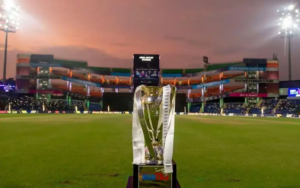IndusInd Bank CEO assures Q4 profitability despite ₹1,520 crore treasury loss
“This is a one-off event and not a recurring issue. We will absorb the loss in this quarter, but the bank’s profitability will continue,” Kathpalia stated in an interview with CNBC-TV18.
Addressing concerns regarding delayed disclosure, he clarified that there was no intentional postponement of information. “We found this anomaly in October 2024 and immediately initiated an internal assessment. An external agency was appointed to review our derivative accounting and ensure compliance with the new Reserve Bank of India (RBI) regulations. As soon as we determined the full impact, we disclosed the findings to the board and the markets,” he added.
Despite the treasury setback, Kathpalia asserted that IndusInd Bank’s capital adequacy ratio (CAR) would remain above 15%. “We are receiving relief on the Microfinance Institution (MFI) portfolio, which will bolster our capital adequacy by 60 basis points. Our financial foundation remains strong, and our CAR will stay above the required regulatory threshold.”
Kathpalia also dismissed speculation regarding an imminent need for a capital raise. “We do not anticipate any capital infusion in the next four quarters. Our business fundamentals are robust, and we are well-positioned to manage our operations without additional capital raising.”
The treasury loss arose from differential accounting practices between the Asset-Liability Management (ALM) desk and the external trading desk, particularly in foreign currency derivatives. The issue became evident when the bank started implementing new RBI investment regulations in April 2024.
While acknowledging the market’s reaction—which saw IndusInd Bank’s stock take a hit due to concerns about transparency—Kathpalia reassured investors that the institution remains fundamentally strong. “We are taking corrective measures, including halting internal hedging practices and moving all forex hedges to the external market. Our operational resilience and business growth trajectory remain intact.”
Looking ahead, Kathpalia reaffirmed his commitment to leading the bank through this phase. “Our priority is to restore investor confidence, enhance financial metrics, and continue growing the bank. The treasury issue will be addressed within this quarter, and we expect to see strong profitability from Q1FY26 onward.”
Edited excerpts:
Q: Derivatives is always tough to understand. Can you explain the problem in simple terms to your investors?
Kathpalia: The problem is specifically in the internal deals for our foreign currency liabilities. The currency risk was hedged through derivative instruments. During a review of the processes in connection with compliance to the RBI circular on investment portfolios, we found that there were some gaps which were coming out. And that was the start of the issue.
If you want to understand the details, in our treasury unit, you have an internal trading desk, which is the ALM desk and the trading desk. These internal deals are forwarded to the external desk for placing it outside. The internal desk follows a hedge accounting while the external is on a mark-to-market. So, over a period of time, there may be a gap. But over the period of the maturity, it actually evens out. But if you pre-terminate a deal, the anomaly exists and that is where the problem arose.
Q: You said that you discovered it when you were implementing the new investment rules, which were effective April 2024. Now, if you are implementing it effective April 2024, you would have prepared for it earlier. How come you didn’t discover it before that, in the process of preparing for April 2024?
Kathpalia: We found this anomaly around October, and that is where we started our internal assessment as well as we hired an external agency. At that point of time, we did not know the difference. We knew that there were two deals getting accounted incorrectly, but there’s so many deals in that. So, we did not know the real impact.
As soon as we got to know the impact, we held a board meeting, and we informed our board, and we did the disclosure.
Q: In your analyst call, you said that this practice of differential accounting by the ALM department and the treasury is about five to seven years. Then how come you got to know of it now? Is it that the amounts were very small in the initial years, but the amount you had lost because of premature withdrawal of deposit was higher in 2023-2024, and so it became a larger number? Is that why you missed it in the earlier years?
Kathpalia: No, not at all. I think it is spread over seven to eight years, like we said. And it came over a period of time. So, there’s no one year which will show the blip. I think it was evenly spread out over a period of time, as and when you do the premature withdrawal and the early termination of the deals, created that impact.
Q: And when did you appoint the external agency?
Kathpalia: October 2024.
Q: But you could have told the investors at that time, you wouldn’t appoint an external agency unless it was a somewhat sizable problem. You didn’t know it was ₹1,000 crores or more than that?
Kathpalia: The number was not known. The external agency was appointed because we were not sure and they were appointed for two specific purposes. One, to understand the derivative accounting and second, we are going into the new version of the treasury backend system, so to understand the processes and restate our processes to make sure that we are in compliance with everything. So that was the mandate which was given to the external agency.
Q: And this external agency was not appointed because of Reserve Bank of India telling you to? It was a suo-moto decision?
Kathpalia: It was the bank’s decision. And the discovery of everything, right now I said we started a parallel process also and as soon as we understood that there was a number which was emerging and we are still not sure of the number, I believe that we are 99.5% there, we wanted to disclose it to the board and to the LODR.
Q: So, what is that approximate loss? You are saying 2.5% of the net worth, there was a source close to a former RBI person with whom I was trying to check, saying ₹2,100 crore, then there are some analysts who are calculating the figure as a percentage of net worth as ₹1,600 crore. So, which is the correct number?
Kathpalia: The number is ₹1,520 crores net of taxes.
Q: The general practise with at least the larger banks is to hedge their exposures with an external agency. Why wasn’t IndusInd Bank doing this to begin with? And specifically, the September 2023 RBI circular does not deal with hedging per se. So, we’re still trying to understand what led to the discovery of this change and despite appointing an external agency, delay in reporting this to exchanges and to investors at large.
Kathpalia: This was not a delay. We took a view that we should not be doing the internal deals and we should only go through the market hedge. And I think that is the call and the circular clearly states that and we changed the classification of our derivatives into what will go into hedge and what will go into mark-to-market. I think that’s number one.
Number two, in my opinion, there was no delay in reporting to the LODR. I think as soon as we discovered the number, it was reported to the LODR. So as a process, we found that there may have been some gap. But very difficult to identify the gap. And as soon as we understood the gap, we immediately came into the LODR and reported the number. So, if you think that we have hidden something, I don’t think the bank has hidden any disclosure at this point of time.
Q: It’s the markets that seem to believe there is a question when it comes to the credibility of the bank. I could recite several brokerage notes that talk about it, that trust is very important for a bank. And because of this delayed disclosure, there is a lack of credibility, which is why you’re seeing the kind of reaction we saw in the stock market, ₹20,000 crores of market cap wiped out in a day’s trade. What will you say to these investors to allay their concerns that there will be no further shocks as well?
Kathpalia: I can only say that when the microfinance issue came in, it was really not an issue. And post that we’ve been very transparent with our disclosures. I think as soon as we got to know this disclosure, we’ve come and disclosed it to the market. This is a one-off item. It’s not a recurring item. And I think we should get over it in this quarter. And after that, I think the bank should be back to the BAU and you should see the growth that the bank is seeing and the profitability which the bank is used to.
Q: You appoint the agency in October 2024 and your CFO resigns on January 17th, 2025. So, it does look like you were aware of something, but the investor gets to know only yesterday. That is a good 60-70 days after the CFO resigns.
Kathpalia: We were aware that there was some problem in the way our processes are running in the internal desk and the internal deals. I was not aware, neither was the bank aware of the size of the problem. I think the size of the problem, the number when it got disclosed to us, we went to the board and got disclosed it.
On the CFO resignation, I think his letter is available on the site and we have to go and believe that he is stating the right facts.
Q: He could have had other reasons, but the appointment of the agency and the resignation of the CFO and this disclosure all seem to follow a pattern, otherwise one would not have doubted why the CFO resigned.
Kathpalia: I think we are reading too much into it.
Q: What is the likely impact on NII and net profit in Q4 itself? Will Q4 be a loss, but not the full year for sure?
Kathpalia: The full year will not be a loss at all. And I think Q4 also will be a profit after taking this into account if we have to.
Q: Why do you say if we have to take into account, I would assume you have to take it into account in Q4, right?
Kathpalia: I am just saying let the amount crystallise. I am still not aware of the full amount. I think it will be this amount, I am 99.9% sure. I think we will absorb this loss in this quarter itself.
Q: Can you give us some idea what will be your capital adequacy after you take into account this loss? What is it now and what might it fall to?
Kathpalia: Will be above 15%. I can tell you we are getting a relief on the MFI because the MFI we had taken at 125%. Now the MFI will work at 75% for business and for consumption purposes at 100%. So even if we take at 50-50%, we will gain about 60 basis points on the MFI. So, you take any calculation, we will still be above 15%.
Q: Yesterday while addressing this matter in the concall with analysts, you also said that perhaps this incident may have had a bearing on the RBI not extending your tenure by three years, but only by one year. Could you explain exactly what you meant when you said RBI may have some discomfort with the way you were running the bank?
Kathpalia: I said I got the second term extension at two years and the third term extension as one year. So, it was more a conjecture on my part. And I think we have to respect the RBI view. So, it was a conjecture which I said that, that may be the rationale. So that’s the only reason I said that. In two consecutive terms, you’re getting either a two year or a one year and not the full term. I think that was the rationale and a conjecture which I used at that point of time.
Q: What has been the RBI’s communication to you in this matter? You have been engaging with them for a while, what do you think caused this?
Kathpalia: I don’t know what caused this, I’m unable to comment on the RBI thing. But the board will look at succession planning, they will look at external and internal candidates to decide what is the way ahead.
Q: How soon could the board meet to discuss the next steps when you talk about succession planning, and will you be considered as one of the candidates for the potential CEO that will be submitted to RBI? What is your understanding?
Kathpalia: That is very difficult for me to conject. What I can say right now is that I have a one-year tenure, I have a lot of work to do. I think the bank has to get back on its feet and show on quarter one that where it stands compared to the peers, we have to get back our profitability. And I think be consistent and get back the trust of the investors as well as the depositors.
Q: On profitability, I am enthused by the fact that you say that even Q4 could be a profit. I can take that as a headline, right? After accounting for a ₹1,520 crore loss, Q4 is likely to be a profit?
Kathpalia: Yes.
Q: What is your sense about how long you will continue? Are you likely to serve the full term or is it likely that the search for a new CEO could be hastened?
Kathpalia: I’m very happy and I have a job to do. I don’t want to leave the bank in a lurch at all. And I think I have created this bank over the five years through granularity and I think the bank today has a very, very strong foundation, leave out this treasury thing which can happen in any bank at any point of time. I think if you look at the liability franchise of the bank, you look at the asset franchise of the bank, I think we’ve got a very, very strong franchise. We’ve come out of microfinance much faster than what others will come out. I can say that you’ll see the bottoming of the microfinance cost at this quarter. And I think the bank is well poised, and I want to show profitability, which this bank stands for. Then I think let the board decide who’s an eligible candidate at that point of time.
Q: This five to seven years is a bit disturbing. I mean, why is it that it surfaced in the seventh year? Why not earlier?
Kathpalia: If I look back at any of the audit reports, risk reports, as well as statutory reports, there is no such thing of this issue. Because I think these are very complicated transactions. And it was between an external desk and an internal desk. And I think it was not there at all. So, I think that may be the reason. But I had no reason to believe at any point of time, seeing all reports which come to me for review, there was any discrepancy in our processes or in our treasury books.
Q: When I checked with some of the bigger banks, they hedge their ALM book with external parties. Is this common practice, to hedge the book with your own unit?
Kathpalia: Now we hedge it with an external party, effective April 1, 2024. We were giving it to an internal desk because they were going to the external party and that is where the two hedges, we have stopped that practice, effective April 2024.
Q: Was there a higher amount of NRI deposits in 2023-2024, which led to perhaps higher other assets, or receivables amount?
Kathpalia: No, not at all. If foreign currency deposits have to be taken, it’s only about $1.2 billion or $2 billion of FCNR. There is more domestic business also in NR, which is the savings account and the NRI deposits. We have a ₹15 lakh crores derivative book.
Q: But you said in the conference call that this was largely because of NRI deposits.
Kathpalia: No, I did not say that. It was because of client deposits and borrowings. When you get foreign currency deposit you decide whether you want to leave it in US dollars or you want to hedge it or you want to convert it into INR. And at that point of time, you decide. So, you have a lot of deposits with lying foreign currency and we place it out. So, it’s not that it’s only a thing of about hedging. It’s also the way the deposits came in. It came into the internal desk. It was given to the external desk to mark to market. One desk took the profit and the other should have also – because in hedging it should actually neutralise at that point of time. And I think when the early termination of the deal happened, the profit got accounted for, but the loss did not get accounted for.
Q: Your NII in the third quarter was ₹5,228 crore. Will it be less by ₹1,600 crore in the fourth quarter?
Kathpalia: Not at all.
Q: What about the PAT? The PAT was ₹1,400 crore.
Kathpalia: What you will see is may be a decline on the NII because we may be taking a lot of hit on our microfinance this quarter and there may be a reversal of interest.
Q: I am intrigued by the fact that you say that you may report even a Q4 profit because your PAT in Q3 was ₹1,400 crore and even the quarter before it was about ₹1,331 crore. So, if you have to take a hit of ₹1,520 crore as you say, assuming that is the number, then it is difficult to find how you may be able to report a profit.
Kathpalia: We have provisions which we have created over a period of time and I think our businesses are doing well. In my opinion, even the MFI, the vehicle finance business and the growth is doing well. I think we managed our expenses very well and I think we should come back to our profitability which we have to do.
Q: While you say the bank will still report a profit, there may be some decline in NII. I just wanted to understand, even with tier-I at 15% plus after this incident, given that the final impact is still not known, you’re still conducting that external review, would you rule out the fact that the bank may need to look at raising capital or is that something that the bank may have to consider in the coming quarter?
Kathpalia: I don’t think the bank will need capital for the next four quarters. We do an assessment every six months and I think as of now, we believe we are well capitalised and we should be able to manage our business. Of course, there will be a loss of CET1 because of this. Because we have a profit, it may not be a loss, but I think we should be able to manage the business.
Q: You said you don’t want to leave the bank in a lurch. You have that one-year term still to go. The MFI portfolio, which has been the cause of concern for the bank in the last couple of quarters, which you had earlier said you expect to bottom out in the coming two quarters. Do you still stand by that view or are you seeing some improvement in the portfolio? What sort of the things you want to finish before this one-year term ends, even in terms of priorities?
Kathpalia: I think the MFI should see bottoming out in quarter four, except one state which is Karnataka and we should be taking that up front in quarter four itself. So, I don’t see that as a concern, that we will not be able to manage the MFI and the growth is coming back, albeit a little slow, but I think we are fine with that.
We also diversified our Bharat Financial Portfolio into merchant acquiring, which is growing at a very fast pace. That’s a ₹7,000 crore book at 26%, which has been able to mitigate some of the risks which were coming in the MFI business.
If you look at my priorities, I continue to believe that our granularisation of liabilities is still 90% there. We still need to continue our granularisation. And when I mean granularisation, I mean that we will also drop our cost of deposits because we seem to be second highest or third highest in the industry. And we need to drop that in peer with the large four banks. We will come to that.
Number two, I continue to believe we need to get our financial metrics back. And I think the bank will start seeing great profitability from Q1 onwards. And we should be back to where we belong by Q3, Q4. So, I think we should start seeing the uptick and the hockey stick approach coming in into the thing.
Number three, our risk cost will again get range bound to 110 to 130 basis point. And we’ll continue to fortify the balance sheet as we move along.
The fourth, I think we need to add another domain expertise. And I believe the bank is ready to add another domain expertise because I believe in good times and bad times, domain expertise, which is our three core businesses have stood the test of time and come out looking very well.
And the fifth part is I continue to invest in distribution technology and continue to create a very robust infrastructure for the growth of business as we go forward.
Q: What will be the new domain expertise that you all are creating?
Kathpalia: I think there are four or five areas, very difficult. I think we believe that affordable housing is a very, very good domain. I think SME lending is a very – we are a bank of business owners and SME lending, we want to create it as a domain expertise. So, we are evaluating multiple options and we will see how to take it forward.
Q: When I asked you about the possibility of profit in the fourth quarter, you said that you will be able to release some of the provisions that you had set aside for MFI, right? How much are you expecting to save on that account?
Kathpalia: Very difficult to say right now. It will not be fair on me to give you a number right now.
Q: But you are expecting that to take away some of this loss, right?
Kathpalia: Yes.
Q: You said that net of taxes, the loss you are counting now is ₹1,520 crore. Will the gross number be ₹2,100?
Kathpalia: The gross number will be about ₹1,970 crores.
Q: Can you give us some idea of how the unsecured book is doing? Has that turned the corner?
Kathpalia: I think the PL book continues to do well. I think if you look at our unsecured business, it’s 5.5% of our book. I think 3% is credit card, 2.5% is personal loan.
The personal loan book continues to do well for us. I think on the credit card, the flows have now stabilised at an elevated level. And we believe that in the next two quarters, we will start seeing declining on the flows.
The credit card profitability did take an impact because of the regulations which underwent the change on the way interest accrual has to happen on the late fees, as well the penal interest has to be charged to the client. And I think the revolving rate did come down in the business.
Q: Your credit growth has been about 12.2%. Will this quarter be better? Have you seen enough demand? As well, a word on your margins. Will there be any relief on that 3.93% that you reported?
Kathpalia: I continue to believe that in Q4, you may see a suppression of margin. But over the next 12 months, I think you should start seeing our margins being 4% and above. That is where the bank will operate, above 4%. And I think the bank will get back to 4% margins.
Q: Despite your disclosure yesterday, your late night concall with the analysts and subsequent clarifications, we even spoke to the promoter entity during the day today. Why do you think investors are not getting that sort of confidence and we saw the kind of reaction we saw and what would your closing message to investors really be?
Kathpalia: The bank is very very solid. I think the bank has domain specialisation which makes it a market leader in the businesses in which it operates. With the change of cycle in the interest rates, the bank gains the most and with the microfinance cycle behind us or any other issues behind us, I think you should start looking for what you look for in a mid-sized bank which is an RoA upwards of 1.5 to 1.8 and I think the bank will start moving towards that in a period of two to three quarters.
So, I continue to believe the bank is fundamentally very strong. Yes, we’ve had our hiccups and the hiccups have not left us. The treasury thing has been a big blow personally to me also, but I think it’s a matter of time that the bank will come up, and I don’t think there are any hidden skeletons in the cupboard, and we are not hiding any losses, or we are not hiding anything from the investors.
There is an absolute transparency in the system, and if I can come and disclose the number before I knew the final number, I think it tantamount’s that we want to be transparent to our investors, and to the media at large, and I don’t think there is a view that we want to hide anything in the market.
Q: One of the headlines I am taking away, is also that you don’t have to report a loss in the current quarter, it could be a profit, right? I’m confirming that with you.
Kathpalia: Yes.
Share this content:














Post Comment